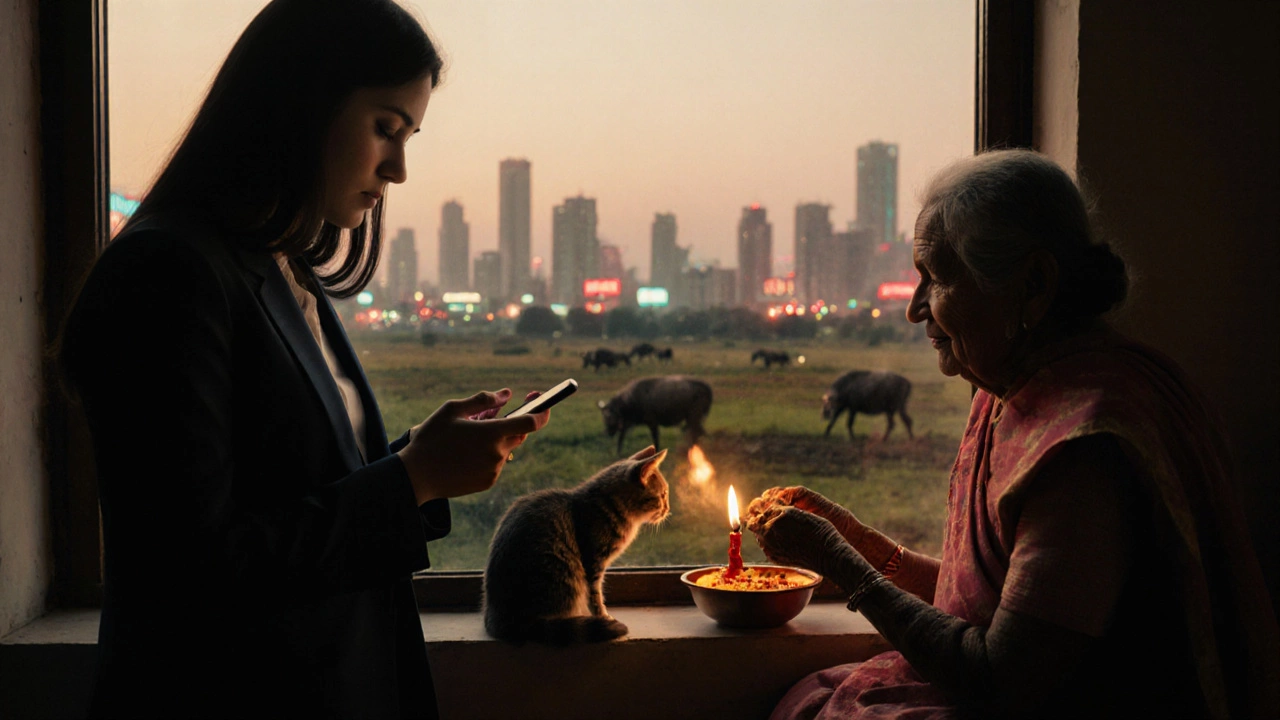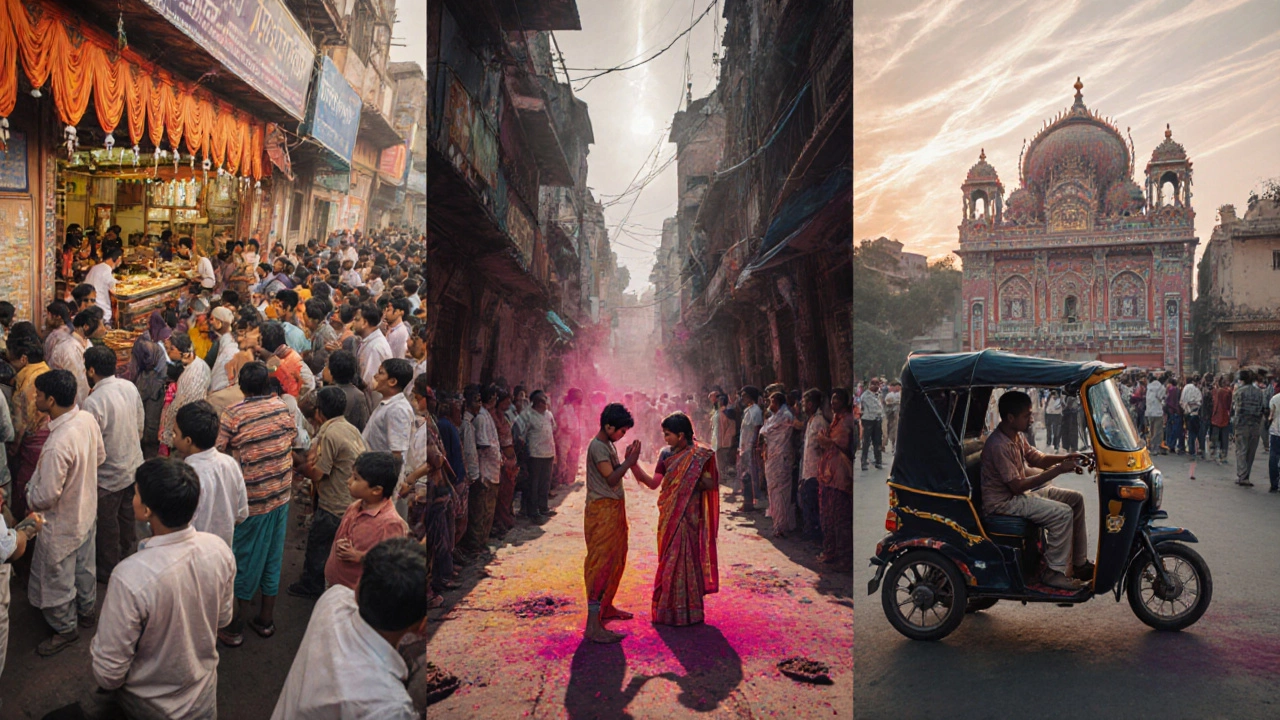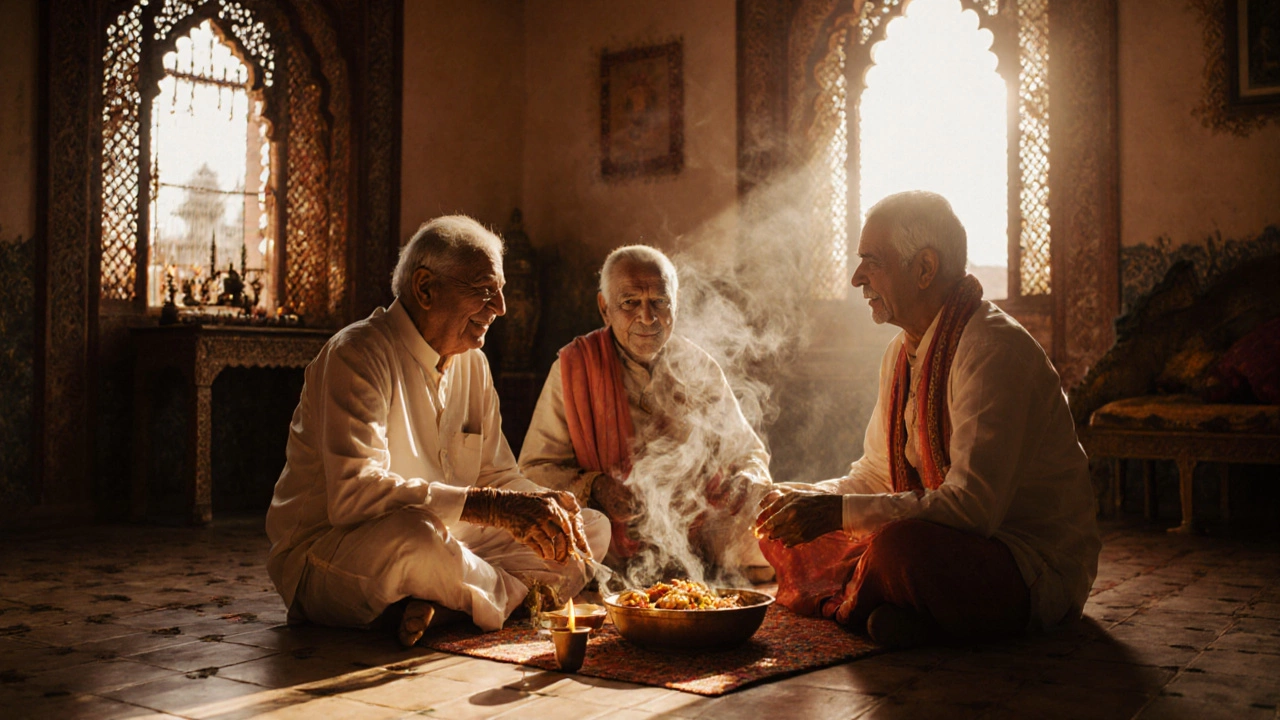Indian Regional Culture Explorer
Select a Topic
Select a Region
Regional Insight
Select a topic and region to see cultural insights
Why This Matters
India isn't a single culture but a mosaic of hundreds of distinct traditions layered over millennia. This tool demonstrates how daily life varies dramatically across different regions while maintaining core values.
India isn’t one single way of living. It’s hundreds of them, layered over thousands of years, shaped by religion, region, language, and economics. If you think you can sum up the way of life in India with a single image-saffron robes, yoga mats, or crowded trains-you’re missing the full picture. The truth is more messy, more beautiful, and far more complex.
Family Comes First-Everywhere
In most parts of India, family isn’t just a group of people you live with. It’s your safety net, your identity, and your responsibility. Whether you’re in a Mumbai high-rise or a village in Bihar, the joint family structure still holds strong in over 70% of households, according to the National Family Health Survey (2023). Grandparents, parents, kids, uncles, aunts-all under one roof, sharing meals, chores, and decisions.
Children don’t leave home after college. They move back in after their first job. Marriages aren’t just about two people-they’re about two families merging. And when someone falls sick, it’s not just the spouse who takes time off. It’s the cousin who drives to the hospital, the aunt who cooks for a week, the uncle who pays the bill.
This isn’t about obligation. It’s about belonging. You don’t ask for help because you’re weak. You ask because you’re part of something bigger.
Food Is More Than Fuel
Breakfast in Delhi might be parathas with pickles. In Chennai, it’s idli and sambar. In Kerala, it’s puttu and kadala curry. In a Punjabi village, it’s makki di roti with sarson ka saag. And in every single case, food is served with love, not just hunger.
Meals aren’t rushed. They’re rituals. Even if you’re eating alone, you sit on the floor. You wash your hands before and after. You never point your feet at the food. In many homes, the first bite is offered to God-or to the dog, the cow, or the stray cat outside. Food is sacred. Wasting it? That’s not just rude. It’s bad luck.
And then there’s the spice. Not just heat. Layered flavors-cumin, coriander, turmeric, asafoetida, cardamom-each added at a precise moment, each with a purpose. Turmeric for healing. Cumin for digestion. Cardamom for calm. Cooking isn’t a hobby. It’s medicine, memory, and art rolled into one.
Work and Time Move Differently
India doesn’t run on the clock the way Western countries do. Meetings start late. Trains arrive late. Bills get paid late. That doesn’t mean people are lazy. It means time is fluid. Relationships matter more than schedules.
In a small town, a shopkeeper might close early to attend a neighbor’s wedding. A teacher might stay after school to help a student’s sibling with homework. A doctor might visit a patient at home because the family can’t afford transport.
Work isn’t just a job. It’s dignity. Over 90% of Indians work in the informal sector-street vendors, rickshaw drivers, home-based tailors, daily wage laborers. No contracts. No benefits. Just survival, skill, and grit. And yet, you’ll see people smiling, laughing, singing while they work. There’s a rhythm to it. A kind of resilience that doesn’t need applause.

Religion Is in the Air
You can’t talk about life in India without talking about faith. Not as a private belief, but as a public rhythm. A temple bell rings at dawn. A mosque’s call to prayer echoes at dusk. A Hindu family lights a diya every evening. A Sikh kitchen feeds 500 strangers for free every day.
There are over 1.3 billion people in India-and more than 20 major religions. Hinduism, Islam, Christianity, Sikhism, Buddhism, Jainism, Zoroastrianism, Judaism-all live side by side. You’ll see a Muslim woman wearing a hijab walking past a Hindu temple with a priest chanting mantras. A Christian school next to a Jain temple with no statues. No one bats an eye.
Festivals aren’t holidays. They’re explosions of color, sound, and community. Diwali turns cities into lanterns. Holi dyes the streets red and green. Eid brings sweets to every doorstep. Christmas bells ring in Goa and Kerala. You don’t have to believe to join. You just have to be there.
Modernity Doesn’t Erase Tradition
India has 5G networks and AI startups. It also has farmers plowing fields with oxen. A 22-year-old in Bangalore codes apps for Silicon Valley while her grandmother prays to Ganesha before every meal. A teenager in Hyderabad watches Netflix after doing her evening aarti.
Technology didn’t replace tradition. It layered on top of it. You can order groceries online and still ask the delivery guy to leave them at the doorstep because the family doesn’t let strangers inside. You can use WhatsApp to plan a wedding, but still hire a pandit to read the horoscope.
Young Indians are the most educated generation in history. But they still bow to elders. They still wear sindoor on their wedding day-even if they’re engineers. They still take off their shoes before entering a home-even if it’s a penthouse in Gurgaon.
This isn’t contradiction. It’s adaptation. Tradition isn’t a relic. It’s a toolkit. You pick what works. You let go of what doesn’t. But you never throw it all away.

The Quiet Rules No One Talks About
There are unwritten rules that shape daily life. You never use your left hand to eat or hand something over. You never say no directly. You say “maybe,” “I’ll try,” or “I’ll see.” You never raise your voice at home. You never argue in public.
Women still carry the weight of expectations-managing households, careers, elders, kids-often without recognition. Men still feel pressure to be the provider, even if they’re earning minimum wage. But there’s change. Slow, quiet, powerful.
More women are starting businesses. More men are cooking. More families are choosing love marriages. More villages have solar panels. More teens are speaking up about mental health. The way of life in India isn’t frozen. It’s breathing.
What You Won’t See in Tourist Photos
You won’t see the 400 million Indians who live on less than $2 a day. You won’t see the water shortages in Hyderabad or the power cuts in Lucknow. You won’t see the single mother working two jobs to send her daughter to school. You won’t see the man who walks 10 kilometers every day to carry bricks because there’s no other work.
But you also won’t see the community that pooled money to fix a broken well. The college student who tutors street kids for free. The neighbor who shares her last roti with a stranger. The way people still stop to help someone whose bike has broken down-even if they’re late for their own appointment.
Life in India isn’t about poverty or grandeur. It’s about presence. About showing up. About finding joy in the small things: a cool breeze after a hot day, the smell of fresh chai, a child’s laugh, a shared silence with someone who understands without words.
It’s Not About Being Perfect. It’s About Being Together.
The way of life in India isn’t a model. It’s a mosaic. Broken pieces. Bright colors. Cracks filled with gold. It’s loud and quiet. Rich and poor. Ancient and new. Chaotic and deeply ordered.
There’s no single answer to what life is like here. But if you spend a week in a village, a month in a city, and listen more than you speak-you’ll start to feel it. Not as a concept. As a rhythm. A heartbeat.
You’ll realize: it’s not about having more. It’s about holding on to what matters.
Is the way of life in India the same across all states?
No. India has 28 states and 8 union territories, each with its own language, food, customs, and traditions. What’s normal in Kerala-matrilineal families and temple festivals-is very different from what’s common in Punjab-joint farms and langar kitchens. Even within states, rural and urban life differ drastically. A farmer in Odisha and a software engineer in Bengaluru live in two different worlds, even if they’re both Indian.
Do Indians still follow traditional values in cities?
Yes, but in new ways. In cities, you’ll see young professionals wearing jeans and t-shirts, but still lighting a diya before leaving for work. They might eat pizza for dinner but refuse to eat with their left hand. They use dating apps but still ask their parents’ permission before getting engaged. Tradition isn’t discarded-it’s adapted. It’s woven into modern life, not replaced by it.
How does religion influence daily routines in India?
Religion shapes the rhythm of the day. Many start with prayer or meditation. Meals are often offered to deities before eating. Festivals dictate holidays and social events. Even non-religious people participate because it’s cultural, not just spiritual. Temples, mosques, gurdwaras, and churches aren’t just places of worship-they’re community centers, schools, and charity hubs.
Is family pressure still strong in modern India?
Yes, but the pressure is changing. Older generations still expect marriage by 25, a stable job, and children. Younger Indians are pushing back-delaying marriage, choosing careers over family expectations, living alone. But even those who rebel often still call their parents daily, visit on weekends, and ask for advice. The bond remains. It’s just becoming more equal.
What’s the biggest misconception about life in India?
That it’s all poverty and chaos. The truth is, India is full of quiet dignity. People work harder than most, often with fewer resources. They celebrate small wins. They find joy in community. They don’t need luxury to be happy. The real story isn’t in the slums or the skyscrapers-it’s in the spaces between: the shared tea, the unsaid support, the laughter in the middle of hardship.
